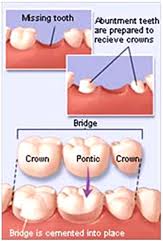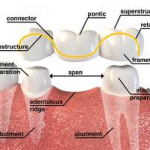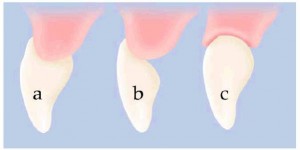In those clinical situations in which missing teeth are replaced with fixed prosthodontics, the clinician is faced with the task of fabricating the pontics to fulfill the requirements of esthetics, form and function, and oral physiotherapy.
 The relationship of the’ ‘dummy tooth’ , or pontic to the underlying ridge is inordinately complex, since the esthetic requirements invariably conflict with those of function and hygiene. Although pontic designs have been discussed in some depth in the literature, descriptions of the pontic form assume the presence of an ideal recipient site. Little attention has been directed to the problem of how the various pontic designs relate to the deformed edentulous ridge or pontic recipient site.
The relationship of the’ ‘dummy tooth’ , or pontic to the underlying ridge is inordinately complex, since the esthetic requirements invariably conflict with those of function and hygiene. Although pontic designs have been discussed in some depth in the literature, descriptions of the pontic form assume the presence of an ideal recipient site. Little attention has been directed to the problem of how the various pontic designs relate to the deformed edentulous ridge or pontic recipient site.
Pontic Designs
Following are the pontic designs most commonly described:
I. Sanitary pontic. This form fulfills the prerequisites for the health of the underlying attachment apparatus or periodontium, because it does not come into any form of contact with the ridge and leaves the proximal areas of the adjacent teeth or abutments free of encumbrances which make oral physiotherapy difficult. The form is certainly not esthetic and it may present a problem to many patients, since the space between the pontic and the ridge becomes a depository for large pieces of food and a site into which the tongue invariably strays.
2. Ridge lap pontic. This pontic design presents problems due to the inability of either the patient or clinician to keep the interface between the pontic and the underlying ridge free of plaque. The tissue becomes inflamed, loses its keratinized surface, and ulcerates. It is generally considered inadvisable to use this type of pontic.
3. Modified ridge lap pontic. This is the most commonly used pontic design; the contact of the pontic with the underlying ridge is maintained only on the buccal aspect of the ridge. This limited contact in only one plane allows the area to be readily cleansed with dental floss and maintained free of inflammation. This type of pontic fulfills most of the needs of the restorative dentist in cases involving ideal edentulous ridges.
4. Ovate pontic. This is a pontic form with a rounded base; it is indicated when esthetics are of paramount importance. It also ideally fulfills the requirements of function and oral physiotherapy. However, it can be utilized only if the recipient site is initially prepared to receive it by some form of surgical procedure, or if the pontic is inserted into the extraction socket at the time of tooth removal. The rounded base of the pontic must be accurately formed to fit the prepared concave recipient site precisely. The intimate relationship allows floss to pass over the convex base, simultaneously cleaning the pontic and the concave surface of the pontic recipient site.
It is the authors’ contention that the ovate pontic is the most useful pontic form. This article will discuss the development of pontic recipient sites, in both the normal and deformed edentulous ridge, to accommodate the ovate pontic design.
The Edentulous Ridge and Pontic Recipient Site
 The ultimate physical and anatomical form of the pontic recipient site is a direct result of the state of the periodontium and the tooth prior to extraction. The presence of periapical pathosis, periodontal disease, or trauma will have a direct influence, as will the age of the patient and the body’s healing potential. It is the responsibility of the exodontist to use judicious care in removing any tooth, since too often the labial or buccal plates are fractured and removed along with the tooth or sequestrated at a later date, resulting in iatrogenic deformities. Improper extraction should be particularly avoided in the anterior region of the mouth, as it can create an unesthetic pontic-to-ridge relationship.
The ultimate physical and anatomical form of the pontic recipient site is a direct result of the state of the periodontium and the tooth prior to extraction. The presence of periapical pathosis, periodontal disease, or trauma will have a direct influence, as will the age of the patient and the body’s healing potential. It is the responsibility of the exodontist to use judicious care in removing any tooth, since too often the labial or buccal plates are fractured and removed along with the tooth or sequestrated at a later date, resulting in iatrogenic deformities. Improper extraction should be particularly avoided in the anterior region of the mouth, as it can create an unesthetic pontic-to-ridge relationship.
The pontic recipient site can, therefore, be defined as being potentially adequate or inadequate depending on whether the ridge area is normal (flat) or deformed (collapsed), as viewed in an apicocoronal (vertical) dimension or a buccolingual (horizontal) dimension.
The preparation of the pontic recipient site in each of the above situations requires individualized attention and specific considerations.
The Normal (Flat) Ridge
For this type of ridge, it is first necessary to determine the anatomical characteristics of the site. When the tooth was removed there may have been osseous fill of the healing socket, making it level with the two interdental peaks of bone. This situation obviously is not ideal, because the bone in the center of this flat pontic site is now at a level more coronal to that point at which the maximal curvature of the cementoenamel junction (CEJ) normally would have been.
The rise and fall of the CEJ of any particular tooth form can be characterized as being highly scalloped or flat, corresponding to the underlying osseous topography and gingival form. The dimension of the additional healing bone fill will equal the distance between the tip of the interdental papilla and the most apical curvature of the free gingival margin. The net effect of this type of flat socket healing is inadequate space for a pontic with dimensions similar to those of the adjacent teeth. The form of the pontic recipient area must, therefore, be assessed relative to that of the adjacent teeth, which may be highly scalloped or flat.
Ideally, the clinician should have the temporary bridge and pontic prepared at the time of extraction so that the ovate pontic can be immediately inserted into the socket and the attachment apparatus allowed to heal around this form. This will prevent the flat healing of the socket straight across the tips of the interdental osseous crests, and will result in an ideal concave pontic recipient site.
If the pontic is not inserted at the time of extraction and esthetics are of prime importance, surgical reduction of the pontic recipient site may become necessary.
